精准扶贫视域下传统村落的保护与旅游开发 ——以湖南省花垣县十八洞村为例
湘西十八洞村文化旅游扶贫现状及对策

湘西十八洞村文化旅游扶贫现状及对策湘西十八洞村位于湖南省张家界市,是一个典型的少数民族村落,也是一个贫困地区。
随着当地旅游业的兴起,十八洞村正逐渐走上了脱贫致富的道路。
本文将围绕湘西十八洞村文化旅游扶贫的现状进行分析,并提出相应的对策,以期能够更好地推动当地的文化旅游产业发展,帮助村民脱贫致富。
十八洞村地处湘西山区,自然环境优美,山清水秀,是游客休闲度假的绝佳之地。
村里的苗族人民以其独特的风俗、民俗文化和传统手工艺闻名,成为了当地文化旅游的一大特色。
近年来,随着国家扶贫政策的深入实施和旅游业的快速发展,湘西十八洞村的文化旅游产业逐渐兴起。
村民们利用自己的民俗文化和传统手工艺,积极发展特色旅游产品,吸引了大量游客前来观光旅游。
由于村庄自然景观优美,当地政府还积极引进外部资金,进行了乡村旅游环境整治,进一步提升了游客的满意度。
尽管文化旅游产业带来了一定的经济收入,但十八洞村的旅游扶贫工作仍面临不少挑战。
由于当地居民的文化传统习惯,部分村民对新兴产业适应性较差,缺乏创新意识,导致了旅游产品同质化严重,难以形成竞争力。
基础设施相对滞后,交通不便、通信不畅等问题限制了文化旅游业的发展。
由于缺乏专业的管理人才和市场营销策划,导致了旅游业的运营效率不高,发展空间有限。
针对湘西十八洞村文化旅游扶贫现状中存在的问题,应采取以下对策,以解决相关问题,推动文化旅游产业的发展。
1.加强文化传承与创新加强对当地民俗文化的调查研究,挖掘民间艺术、传统手工艺等特色文化资源,注重文化传承和保护。
鼓励村民创新发展,结合现代科技手段,开发创意旅游产品,使其更符合当代旅游者的需求。
2.完善基础设施加大对基础设施建设的投入力度,改善交通、通信等基础设施条件,提高游客的出行便利度和游憩环境品质。
3.加强人才培养加强对当地旅游从业人员的培训,提升其服务水平和管理能力。
引进相关专业人才,提高旅游管理水平,增强竞争力。
4.健全营销体系建立健全的营销体系,发挥政府引导作用,加强与周边地区的合作交流,拓宽营销渠道,积极扩大文化旅游的影响力和知名度。
湘西十八洞村文化旅游扶贫现状及对策
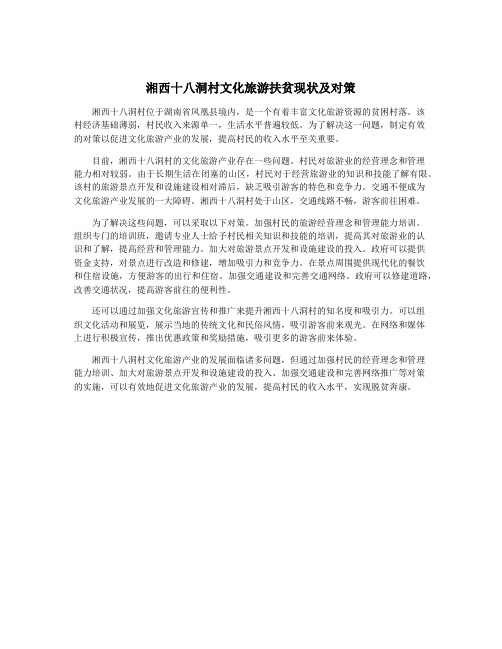
湘西十八洞村文化旅游扶贫现状及对策湘西十八洞村位于湖南省凤凰县境内,是一个有着丰富文化旅游资源的贫困村落。
该村经济基础薄弱,村民收入来源单一,生活水平普遍较低。
为了解决这一问题,制定有效的对策以促进文化旅游产业的发展,提高村民的收入水平至关重要。
目前,湘西十八洞村的文化旅游产业存在一些问题。
村民对旅游业的经营理念和管理能力相对较弱。
由于长期生活在闭塞的山区,村民对于经营旅游业的知识和技能了解有限。
该村的旅游景点开发和设施建设相对滞后,缺乏吸引游客的特色和竞争力。
交通不便成为文化旅游产业发展的一大障碍。
湘西十八洞村处于山区,交通线路不畅,游客前往困难。
为了解决这些问题,可以采取以下对策。
加强村民的旅游经营理念和管理能力培训。
组织专门的培训班,邀请专业人士给予村民相关知识和技能的培训,提高其对旅游业的认识和了解,提高经营和管理能力。
加大对旅游景点开发和设施建设的投入。
政府可以提供资金支持,对景点进行改造和修建,增加吸引力和竞争力。
在景点周围提供现代化的餐饮和住宿设施,方便游客的出行和住宿。
加强交通建设和完善交通网络。
政府可以修建道路,改善交通状况,提高游客前往的便利性。
还可以通过加强文化旅游宣传和推广来提升湘西十八洞村的知名度和吸引力。
可以组织文化活动和展览,展示当地的传统文化和民俗风情,吸引游客前来观光。
在网络和媒体上进行积极宣传,推出优惠政策和奖励措施,吸引更多的游客前来体验。
湘西十八洞村文化旅游产业的发展面临诸多问题,但通过加强村民的经营理念和管理能力培训、加大对旅游景点开发和设施建设的投入、加强交通建设和完善网络推广等对策的实施,可以有效地促进文化旅游产业的发展,提高村民的收入水平,实现脱贫奔康。
湘西十八洞村文化旅游扶贫现状及对策

湘西十八洞村文化旅游扶贫现状及对策1. 引言1.1 背景介绍湘西十八洞村位于湖南省湘西自治州,是一个地处偏远、交通不便的小村庄。
这里的土地贫瘠,山高林密,人口稀少。
十八洞村曾经是贫困村,村民生活困苦,缺乏可持续的经济来源。
为了改善村民生活,提高村庄整体发展水平,政府提出了发展文化旅游扶贫的政策。
历经多年的发展,十八洞村已初步建立了以传统文化、生态风光、民俗民风等特色为主要内容的文化旅游产业。
村内修缮了古老的土楼和祠堂,开发了森林茶园和民俗文化展示馆,吸引了不少游客前来观光游玩。
文化旅游产业为村民增加了收入,提高了整体生活水平,也为当地经济发展增添了新的动力。
目前十八洞村文化旅游扶贫工作还存在一些问题和挑战。
在接下来的文章中,将对十八洞村文化旅游现状进行深入分析,找出问题所在,并提出一些可行的对策和建议,为进一步发展文化旅游产业提供参考和指导。
到此结束。
1.2 问题意识湘西十八洞村是一个地处湖南省西南部的贫困山区村落,素有“百里画廊”之称,是一个具有悠久历史和丰富文化遗产的地方。
由于长期受限于地理环境和资源条件,该村的经济发展一直较为落后,村民的生活水平也较低。
在当前经济发展和旅游业蓬勃发展的时代背景下,湘西十八洞村的文化旅游潜力被越来越多人所关注。
目前该村的文化旅游扶贫工作仍存在一些问题,主要表现在以下几个方面:文化旅游资源开发不够充分,缺乏吸引力和竞争力。
由于历史原因和地理条件,该村的文化景点和民俗风情尚未被有效挖掘和宣传,无法吸引更多游客前来参观体验。
服务品质有待提升,设施设备简陋,服务意识不够强烈。
由于该村基础设施和服务水平相对较低,游客在景区内的游览和住宿体验不佳,影响了他们的满意度和再次光顾意愿。
宣传营销力度不够,知名度和影响力较弱。
虽然湘西十八洞村拥有丰富的文化资源和独特的风土人情,但其在市场推广和宣传方面做得不够充分,使得外界缺乏对其的了解和认可度。
湘西十八洞村的文化旅游扶贫工作仍存在一些问题和挑战,需要进一步制定有效的对策措施来解决。
我国民族地区精准扶贫的治理经验探析——以湖南湘西十八洞村为例
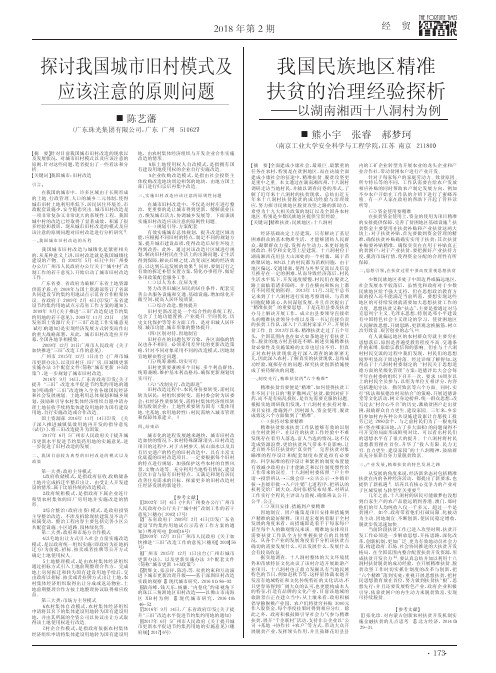
经贸
探讨我国城市旧村模式及 我国民族地区精准
应该注意的原则问题
■ 陈艺藩
(广东珠光集团有限公司,广东 广州 510627)
【摘 要】针对目前我国城市旧村改造的现状以 及发展状况,对城市旧村模式以及应该注意的 原则,针对这些问题,笔者提出了一些看法和分 析。 【关键词】我国城市;旧村改造
地,由农村集体经济组织与开发企业合作实施 改造的情形。
8.原土地使用权人自改模式,是指拥有国 有建设用地使用权的企业自行实施改造。
9.企业收购改造模式,是指由社会投资主 体收购改造地块周边相邻的地块,由地方国土 部门进行归宗后再集中改造。
三 、实 施 旧 村 改 造 应 该 注 意 的 原 则 性 问 题
在城市旧村改造中,不仅是对村庄进行整 治,更重要的是让城市得到更新,缓解就业压 力,焕发城市活力,协调城乡发展等。下面谈谈 实施旧村改造应该注意的原则性问题。
(一)规划引导,方案配套 有效实施城市总体规划,提升改造区域功 能,应根据不同旧村的特点,制定不同的规划方 案,提升城市建设品质,使得改造后居住环境上 得到改善;此外,通过对该改造片区域进行规 划,解决旧村村民在生活上的出路问题,让生活 得到保障,解决后顾之忧,改变该区域的经济效 益,以达到长远发展的效果[6]。同时,要制订行之 有效的拆迁补偿安置方案,简化办事程序,做好 各项政策配套服务工作。 (二)以人为本、宜居为重 努力改善旧城区居民的居住条件,配套完 善公共服务设施和交通、基础设施,增加绿化开 敞空间,提高人居环境质量。 (三)综合改造,整体提升 旧村更新改造是一个综合性的系统工程, 包含了土地功能置换、产业提升、空间优化、历 史文化保护等等多方面工作,是对旧城人居环 境、城市功能、城市形象的整体提升。 (四)区别对待,因地制宜 旧村存在的问题包罗万象,各区面临的情 况也各不相同。必须采用差异化的更新改造策 略,针对不同对象采用不同的改造模式,因地制 宜地解决特定问题。 (五)统筹兼顾,切实可行 旧村更新要兼顾多个目标、多个利益群体, 统筹兼顾,维护基本利益格局,确保更新规划切 实可行。 (六)“改制先行,改造跟进” 旧村改造过程中,农民身份要转变,需村民 转为居民;村组织要转变,需村委会转为居委 会;社经济性质要转变,需将村集体经济组织转 制为股制企业;土地性质要转为国有 (集体用 地、宅基地、农用地转性);村民需纳入城市管理 和保障体系建立。[1]
湘西十八洞村文化旅游扶贫现状及对策
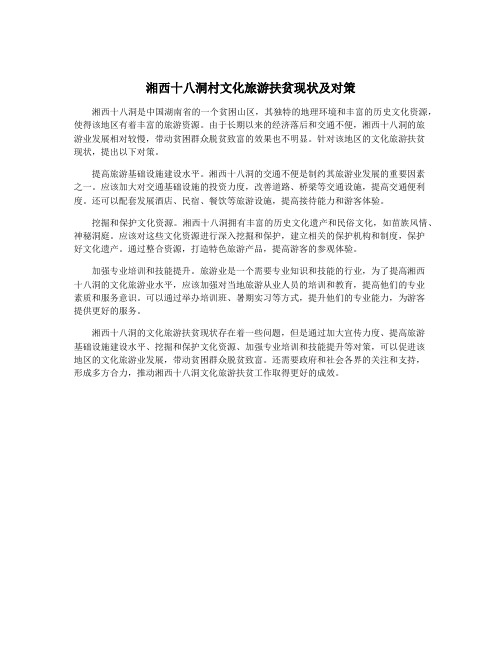
湘西十八洞村文化旅游扶贫现状及对策
湘西十八洞是中国湖南省的一个贫困山区,其独特的地理环境和丰富的历史文化资源,使得该地区有着丰富的旅游资源。
由于长期以来的经济落后和交通不便,湘西十八洞的旅
游业发展相对较慢,带动贫困群众脱贫致富的效果也不明显。
针对该地区的文化旅游扶贫
现状,提出以下对策。
提高旅游基础设施建设水平。
湘西十八洞的交通不便是制约其旅游业发展的重要因素
之一。
应该加大对交通基础设施的投资力度,改善道路、桥梁等交通设施,提高交通便利度。
还可以配套发展酒店、民宿、餐饮等旅游设施,提高接待能力和游客体验。
挖掘和保护文化资源。
湘西十八洞拥有丰富的历史文化遗产和民俗文化,如苗族风情、神秘洞庭。
应该对这些文化资源进行深入挖掘和保护,建立相关的保护机构和制度,保护
好文化遗产。
通过整合资源,打造特色旅游产品,提高游客的参观体验。
加强专业培训和技能提升。
旅游业是一个需要专业知识和技能的行业,为了提高湘西
十八洞的文化旅游业水平,应该加强对当地旅游从业人员的培训和教育,提高他们的专业
素质和服务意识。
可以通过举办培训班、暑期实习等方式,提升他们的专业能力,为游客
提供更好的服务。
湘西十八洞的文化旅游扶贫现状存在着一些问题,但是通过加大宣传力度、提高旅游
基础设施建设水平、挖掘和保护文化资源、加强专业培训和技能提升等对策,可以促进该
地区的文化旅游业发展,带动贫困群众脱贫致富。
还需要政府和社会各界的关注和支持,
形成多方合力,推动湘西十八洞文化旅游扶贫工作取得更好的成效。
《参观十八洞村浅谈精准扶贫》

《参观十八洞村浅谈精准扶贫》参观十八洞村浅谈精准扶贫单位组织全体干部职工赴湘西十八洞村学习考察精准扶贫工作。
作为一名扶贫干部,到十八洞村学习受益匪浅,感受颇多。
回来之后,将学习感悟记录如后。
湖南省湘西土家族苗族自治州花垣县双龙镇有个十八洞村。
村旁山中有18个溶洞,洞洞相连,深不可测。
这个苗族聚居的山寨地处武陵山连片特困地区中心地带,全村225户,939人,人均耕地0.83亩,长期陷入贫困。
202x年11月3日,xx来到在十八洞村,在苗族贫困户施齐文家中看望,坐下来同一家人算收支账,询问有什么困难、有什么打算,察看了谷仓、床铺、灶房、猪圈,勉励一家人增强信心,在党和政府关心下用勤劳和智慧创造美好生活。
地处武陵山腹地的十八洞村风景优美,有“小张家界”之称。
曾经与优美的自然风光形成强烈反差的,是这里的贫穷。
202x年,全村人均收入仅1668元,仅为全国人均收入水平的18.8%。
而如今的十八洞村,在短短的6年时间里,如同凤凰,不仅摆脱了贫困,还接待了前来参观的外国元首,“可复制、可推广”的精准扶贫经验从十八洞村出发,走出湘西,走出湖南,走向全国,甚至走向世界。
一、十八洞村精准扶贫精准脱贫的基本经验(一)坚持规划引领,实施精准发力。
精准扶贫的核心内容是“六个精准”解决“四个问题”。
十八洞村在深刻理解上述精准扶贫核心内容的基础上,以规划为引领,通过制定全村整体发展规划、扶贫脱贫项目规划和农户个体脱贫规划等系列规划,实施精准发力。
一是工作队严格遵循xx提出的精准扶贫“可复制、可推广”的原则,为十八洞村制定了《十八洞村精准扶贫精准脱贫规划》。
二是在全村整体发展规划的统领下,十八洞村结合“五个一批”制定了一系列相互支撑的扶贫脱贫项目规划。
三是在全村整体发展规划、扶贫脱贫项目规划的基础上,工作组通过精准识别,根据每户贫困户的致贫原因、实际困难,按照“五个一批”的要求,将贫困户落实到具体的扶贫项目中,为贫困户制定个体脱贫规划。
湘西十八洞村文化旅游扶贫现状及对策
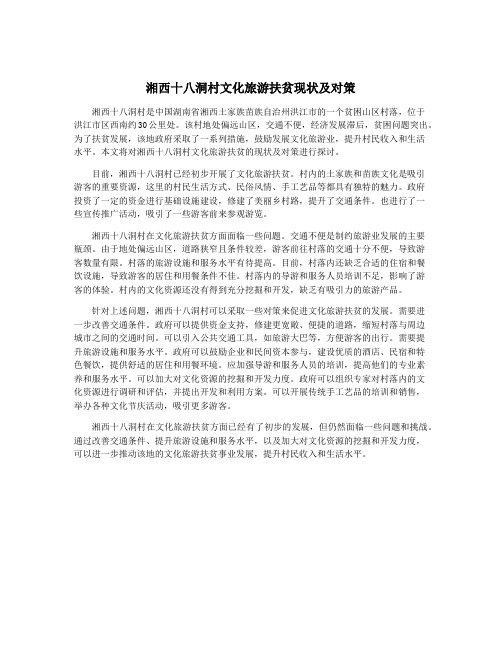
湘西十八洞村文化旅游扶贫现状及对策湘西十八洞村是中国湖南省湘西土家族苗族自治州洪江市的一个贫困山区村落,位于洪江市区西南约30公里处。
该村地处偏远山区,交通不便,经济发展滞后,贫困问题突出。
为了扶贫发展,该地政府采取了一系列措施,鼓励发展文化旅游业,提升村民收入和生活水平。
本文将对湘西十八洞村文化旅游扶贫的现状及对策进行探讨。
目前,湘西十八洞村已经初步开展了文化旅游扶贫。
村内的土家族和苗族文化是吸引游客的重要资源,这里的村民生活方式、民俗风情、手工艺品等都具有独特的魅力。
政府投资了一定的资金进行基础设施建设,修建了美丽乡村路,提升了交通条件。
也进行了一些宣传推广活动,吸引了一些游客前来参观游览。
湘西十八洞村在文化旅游扶贫方面面临一些问题。
交通不便是制约旅游业发展的主要瓶颈。
由于地处偏远山区,道路狭窄且条件较差,游客前往村落的交通十分不便,导致游客数量有限。
村落的旅游设施和服务水平有待提高。
目前,村落内还缺乏合适的住宿和餐饮设施,导致游客的居住和用餐条件不佳。
村落内的导游和服务人员培训不足,影响了游客的体验。
村内的文化资源还没有得到充分挖掘和开发,缺乏有吸引力的旅游产品。
针对上述问题,湘西十八洞村可以采取一些对策来促进文化旅游扶贫的发展。
需要进一步改善交通条件。
政府可以提供资金支持,修建更宽敞、便捷的道路,缩短村落与周边城市之间的交通时间。
可以引入公共交通工具,如旅游大巴等,方便游客的出行。
需要提升旅游设施和服务水平。
政府可以鼓励企业和民间资本参与,建设优质的酒店、民宿和特色餐饮,提供舒适的居住和用餐环境。
应加强导游和服务人员的培训,提高他们的专业素养和服务水平。
可以加大对文化资源的挖掘和开发力度。
政府可以组织专家对村落内的文化资源进行调研和评估,并提出开发和利用方案。
可以开展传统手工艺品的培训和销售,举办各种文化节庆活动,吸引更多游客。
湘西十八洞村在文化旅游扶贫方面已经有了初步的发展,但仍然面临一些问题和挑战。
花垣精准扶贫工作的十八洞探索
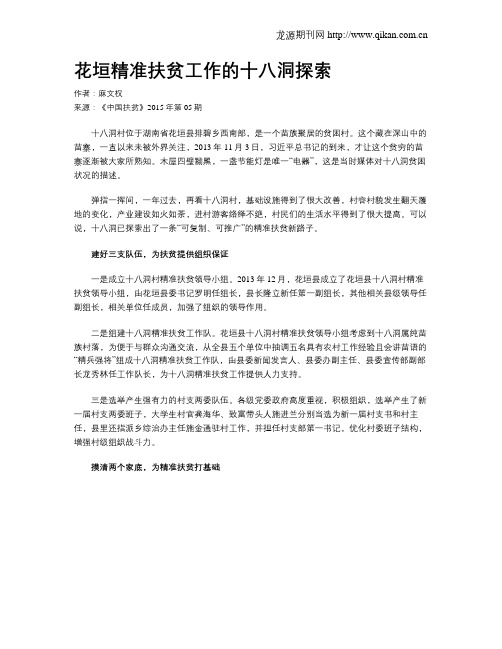
花垣精准扶贫工作的十八洞探索作者:麻文权来源:《中国扶贫》2015年第05期十八洞村位于湖南省花垣县排碧乡西南部,是一个苗族聚居的贫困村。
这个藏在深山中的苗寨,一直以来未被外界关注,2013年11月3日,习近平总书记的到来,才让这个贫穷的苗寨逐渐被大家所熟知。
木屋四壁黝黑,一盏节能灯是唯一“电器”,这是当时媒体对十八洞贫困状况的描述。
弹指一挥间,一年过去,再看十八洞村,基础设施得到了很大改善,村容村貌发生翻天覆地的变化,产业建设如火如荼,进村游客络绎不绝,村民们的生活水平得到了很大提高。
可以说,十八洞已探索出了一条“可复制、可推广”的精准扶贫新路子。
建好三支队伍,为扶贫提供组织保证一是成立十八洞村精准扶贫领导小组。
2013年12月,花垣县成立了花垣县十八洞村精准扶贫领导小组,由花垣县委书记罗明任组长,县长隆立新任第一副组长,其他相关县级领导任副组长,相关单位任成员,加强了组织的领导作用。
二是组建十八洞精准扶贫工作队。
花垣县十八洞村精准扶贫领导小组考虑到十八洞属纯苗族村落,为便于与群众沟通交流,从全县五个单位中抽调五名具有农村工作经验且会讲苗语的“精兵强将”组成十八洞精准扶贫工作队,由县委新闻发言人、县委办副主任、县委宣传部副部长龙秀林任工作队长,为十八洞精准扶贫工作提供人力支持。
三是选举产生强有力的村支两委队伍。
各级党委政府高度重视,积极组织,选举产生了新一届村支两委班子,大学生村官龚海华、致富带头人施进兰分别当选为新一届村支书和村主任,县里还指派乡综治办主任施金通驻村工作,并担任村支部第一书记,优化村委班子结构,增强村级组织战斗力。
摸清两个家底,为精准扶贫打基础一是摸清产业家底。
十八洞村位于花垣县排碧乡西南部,紧临吉茶高速、209和319国道,距县城34公里,距矮寨大桥8公里,于2005年7月由原来的竹子、飞虫两个村合并而成,因村内有18个天然溶洞而得名。
全村有耕地817亩(旱土200亩,水田617亩),林地11093亩,森林覆盖率78%。
湘西十八洞村文化旅游扶贫现状及对策

湘西十八洞村文化旅游扶贫现状及对策湘西十八洞村位于湖南省高山深谷的偏远地区,由于地理位置偏僻,经济发展缓慢,贫困问题突出。
为了改善村民的生活,提高他们的收入水平,湘西十八洞村转向文化旅游业发展,希望通过开发当地的自然风光和独特的民俗文化资源,吸引游客,促进经济发展和扶贫工作。
由于多种原因,湘西十八洞村的文化旅游业目前仍存在一些问题和挑战。
以下是当前湘西十八洞村文化旅游扶贫现状及应对策略的描述。
湘西十八洞村的基础设施建设仍然不完善。
由于地理环境的限制,村庄的道路、电力、饮水和通信等基础设施建设相对滞后,给文化旅游业的发展带来很大的困难,影响了游客的流动和游览体验。
政府和相关部门应加大基础设施建设的力度,改善交通、供水、供电等方面的条件,为文化旅游的健康发展创造良好的条件。
湘西十八洞村在文化传承和展示方面还存在一定的问题。
虽然该村有着丰富的民俗文化资源,但目前缺乏有效的保护和传承机制。
许多传统宗教活动、民间艺术和手工艺品等正在逐渐消亡。
为了保护和传承这些珍贵的文化遗产,政府和相关机构应加强对村庄文化的调研、记录和整理工作,制定相应的保护政策和措施,激发村民对传统文化的兴趣和参与度。
湘西十八洞村在宣传和市场化方面还存在一些不足。
目前,该村在推广自身的文化旅游产品和吸引游客方面工作不到位。
缺乏针对性的宣传材料、宣传渠道和营销策略,导致该村的知名度和影响力有限。
为了提高湘西十八洞村的知名度和吸引力,相关部门应加大宣传力度,联合旅游公司及互联网平台,扩大村庄的曝光度,提升文化旅游产品的市场价值。
湘西十八洞村文化旅游产业链条不完整,缺乏对旅游综合体的规划和建设。
目前,该村的旅游业还停留在简单的景区开发阶段,酒店、餐饮、交通和购物等配套设施建设不完善。
为了充分发挥文化旅游的辐射带动作用,相关部门应加强规划和设计,建设文化旅游综合体,提供全方位、一体化的服务,满足游客的多样化需求,使游客更好地体验当地的文化和生活。
湘西十八洞村文化旅游扶贫现状及对策

湘西十八洞村文化旅游扶贫现状及对策湘西十八洞村位于湖南省凤凰县,是著名的少数民族村落,也是湖南省级贫困村。
村落周围山峦叠嶂,风景秀丽,村民以苗族为主,历史悠久,文化传统深厚。
由于地理位置偏僻,交通不便,以及长期贫困的影响,导致十八洞村的经济发展依然十分艰难。
为了帮助村民脱贫致富,提高生活水平,当地政府和有关部门已经采取了一系列的文化旅游扶贫措施,取得了一定的成绩。
在现实中仍然存在一些问题和困难,需要进一步采取措施加以解决。
一、现状分析1. 湘西十八洞村的文化资源丰富,拥有悠久的苗族文化传统和民俗风情。
这些文化资源可以成为发展旅游业的宝贵财富,吸引更多的游客前来参观和体验。
2. 村落周围的自然景观优美,山清水秀,是徒步、登山、摄影等户外活动的绝佳场所,具有很大的旅游开发潜力。
3. 十八洞村的基础设施相对滞后,交通不便,通讯设施落后,不利于文化旅游业的发展。
4. 村民的生产生活条件较差,大部分人仍然靠传统的农耕生活为主,收入水平不高,脱贫任务艰巨。
二、存在的问题1. 文化旅游产业发展缓慢,吸引游客数量有限,收入较低。
2. 基础设施不完善,无法满足文化旅游的需求。
3. 村民的观念相对守旧,接受新的文化旅游产业理念有一定的抵触情绪。
三、对策建议1. 加大对文化旅游产业的扶持力度,通过政策、资金扶持等措施,鼓励和引导当地企业家和投资者来十八洞村进行文化旅游项目投资。
2. 改善基础设施,提高交通和通讯设施,增加投资者的信心,使文化旅游产业得到更好的发展。
3. 加强对村民的宣传与教育,提高他们对文化旅游产业的认识和接受度,从而更好的参与到文化旅游事业中来,使其受益,并且将传统文化发扬光大。
4. 发挥当地独特的文化和自然资源优势,推出更具吸引力的旅游产品,提高游客的参与度和体验度。
5. 开展文化旅游扶贫培训活动,提高村民的文化旅游知识水平,培养一批懂行的导游和员工,提高服务质量和水平。
四、结语湘西十八洞村的文化旅游扶贫任务是一项长期的工作,需要政府部门、企业家、投资者以及当地村民的共同努力。
湘西十八洞村文化旅游扶贫现状及对策

湘西十八洞村文化旅游扶贫现状及对策1. 引言1.1 背景介绍湘西十八洞村位于湖南省湘西土家族苗族自治州,是一个典型的少数民族聚居区。
这里山清水秀,民风淳朴,文化传统悠久。
由于地处偏远,交通不便,经济基础薄弱,十八洞村长期以来一直面临着贫困困境。
随着旅游业的兴起,文化旅游成为了扶贫的重要途径。
湘西十八洞村拥有独特的土家族文化和风土人情,吸引了许多游客前来观光、体验。
现阶段仍然存在着一些问题,比如基础设施落后、文化资源未得到有效挖掘和保护、特色旅游产品缺乏等。
本文旨在探讨湘西十八洞村文化旅游扶贫的现状及对策,希望通过挖掘本地文化资源、开发特色旅游产品等措施,进一步促进该地区的经济发展,改善当地居民的生活状况。
1.2 问题现状湘西十八洞村是一个位于湖南省西南部的少数民族村落,以其独特的民族文化和风土人情而闻名。
随着时代的变迁和现代化的冲击,十八洞村的传统文化逐渐消失,村民的生活水平也未能得到显著提升。
问题现状主要表现在以下几个方面:一是经济发展滞后。
由于地理环境偏僻、交通不便、资源匮乏等因素,导致十八洞村的产业结构单一,经济发展滞后,村民收入水平较低。
二是文化传承不易。
随着城市化进程的加快和外来文化的渗透,十八洞村的传统文化逐渐失去了传承的环境和条件,年轻一代的文化认同感逐渐淡薄。
三是旅游开发不足。
尽管拥有丰富的民俗文化资源,但由于缺乏有效的开发和推广,十八洞村的旅游产业发展迟缓,无法吸引更多的游客和投资。
以上问题的存在,使得十八洞村的扶贫工作面临巨大的挑战。
如何有效地整合资源、挖掘潜力,促进当地经济发展,保护和传承传统文化,成为当前亟待解决的问题。
【问题现状】。
1.3 研究目的研究目的是为了深入了解湘西十八洞村文化旅游扶贫的现状,分析其存在的问题和原因,提出针对性的对策和建议。
通过对本地文化特色的挖掘和保护,以及开发特色旅游产品,在促进文化旅游业发展的同时带动当地经济增长和脱贫致富。
我们也希望通过本研究的全面展示和总结,对未来湘西十八洞村文化旅游扶贫工作提供参考和借鉴,为促进全国贫困地区的文化旅游发展做出贡献。
湘西十八洞村文化旅游扶贫现状及对策

湘西十八洞村文化旅游扶贫现状及对策湘西十八洞村位于湖南省凤凰县,是一个以苗族为主的少数民族村落。
由于地理条件偏远,交通不便,加上长期贫困,这里的居民一直生活在贫困线附近。
为了扶贫,发展文化旅游成为了湘西十八洞村的一个重要途径。
本文将对湘西十八洞村文化旅游扶贫的现状及对策进行分析。
湘西十八洞村的文化旅游资源丰富,拥有独特的苗族文化和自然风景。
这里的民居保留了传统苗族建筑的特点,村内还有苗族特色的手工艺品、传统乐器等。
村外的自然景观也吸引了很多游客,比如黄果树瀑布、天心国家森林公园等。
这些资源为湘西十八洞村的文化旅游发展提供了良好的基础。
湘西十八洞村目前的文化旅游扶贫还存在一些问题。
基础设施建设不完善,交通不便是游客来到这里的一大障碍。
村内的服务设施和旅游接待能力有限,无法满足游客的需求。
落后的管理体制和相对薄弱的市场推广,限制了文化旅游的发展。
为了解决这些问题,需要采取以下对策。
加大基础设施建设力度,改善交通状况。
政府应该加大对道路和桥梁等基础设施的投入,提高交通的便利性。
加大对服务设施和旅游接待能力的投入。
政府可以组织培训班,提升村民的服务意识和服务技能,培养更多的导游和旅游从业人员。
还可以引入合作社等机构,提供更加专业的服务。
加强管理体制建设和市场推广。
政府可以建立健全村民自治组织,强化村级管理,提高村民的自治能力。
加大对湘西十八洞村文化旅游的市场推广力度,扩大知名度,吸引更多的游客。
湘西十八洞村的文化旅游扶贫有着巨大的潜力。
通过加大对基础设施建设、服务设施和旅游接待能力的投入,以及加强管理体制建设和市场推广,可以推动湘西十八洞村文化旅游的发展,促进村民脱贫致富,提高他们的生活水平。
这也能够保护和传承苗族的优秀文化,增强民族凝聚力和民族自豪感。
湘西十八洞村文化旅游扶贫现状及对策
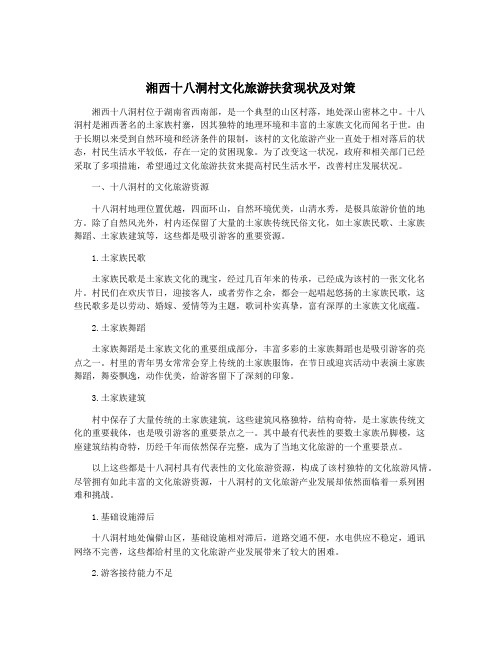
湘西十八洞村文化旅游扶贫现状及对策湘西十八洞村位于湖南省西南部,是一个典型的山区村落,地处深山密林之中。
十八洞村是湘西著名的土家族村寨,因其独特的地理环境和丰富的土家族文化而闻名于世。
由于长期以来受到自然环境和经济条件的限制,该村的文化旅游产业一直处于相对落后的状态,村民生活水平较低,存在一定的贫困现象。
为了改变这一状况,政府和相关部门已经采取了多项措施,希望通过文化旅游扶贫来提高村民生活水平,改善村庄发展状况。
一、十八洞村的文化旅游资源十八洞村地理位置优越,四面环山,自然环境优美,山清水秀,是极具旅游价值的地方。
除了自然风光外,村内还保留了大量的土家族传统民俗文化,如土家族民歌、土家族舞蹈、土家族建筑等,这些都是吸引游客的重要资源。
1.土家族民歌土家族民歌是土家族文化的瑰宝,经过几百年来的传承,已经成为该村的一张文化名片。
村民们在欢庆节日,迎接客人,或者劳作之余,都会一起唱起悠扬的土家族民歌,这些民歌多是以劳动、婚嫁、爱情等为主题,歌词朴实真挚,富有深厚的土家族文化底蕴。
2.土家族舞蹈土家族舞蹈是土家族文化的重要组成部分,丰富多彩的土家族舞蹈也是吸引游客的亮点之一。
村里的青年男女常常会穿上传统的土家族服饰,在节日或迎宾活动中表演土家族舞蹈,舞姿飘逸,动作优美,给游客留下了深刻的印象。
3.土家族建筑村中保存了大量传统的土家族建筑,这些建筑风格独特,结构奇特,是土家族传统文化的重要载体,也是吸引游客的重要景点之一。
其中最有代表性的要数土家族吊脚楼,这座建筑结构奇特,历经千年而依然保存完整,成为了当地文化旅游的一个重要景点。
以上这些都是十八洞村具有代表性的文化旅游资源,构成了该村独特的文化旅游风情。
尽管拥有如此丰富的文化旅游资源,十八洞村的文化旅游产业发展却依然面临着一系列困难和挑战。
1.基础设施滞后十八洞村地处偏僻山区,基础设施相对滞后,道路交通不便,水电供应不稳定,通讯网络不完善,这些都给村里的文化旅游产业发展带来了较大的困难。
新十六字方针的经典案例

新十六字方针的经典案例精准扶贫“十六字”方针助推十八洞村巨变“7月份,平均每天有3000多名游客来到村里旅游观光。
”8月8日,花垣县十八洞村村支书龙书伍告诉记者,游客越来越多,村民们的收入也越来越高。
十八洞村曾是深度贫困村。
2013年11月3日,习近平总书记在十八洞村考察时,首次提出了“实事求是、因地制宜、分类指导、精准扶贫”的“十六字”方针。
按照精准扶贫“十六字”方针,十八洞村在脱贫致富的道路上阔步向前,由之前的贫困村、产业空心村蝶变成小康村、全国乡村旅游示范村。
十八洞村的成功经验获得了中组部的推介,并入选了中组部编选的《贯彻落实习近平新时代中国特色社会主义思想、在改革发展中攻坚克难案例》。
精准扶贫重在精准十八洞村按照“实事求是”要求,精准识别,“防止穷人落榜富人戴帽”。
制定了《十八洞村精准扶贫贫困户识别工作办法》和“十八洞村贫困农户识别9个不评”的标准。
即,有楼房或商品房的不评,违反计划生育政策的不评,嗜赌成性及劳教不改的不评,不务正业及懒惰成性的不评,不履行赡养义务的不评,阻碍当地经济发展的不评,全家外出务工通知不回的不评,国家公职人员不评,拥有大中型农业机械和各类车辆及加工厂的不评。
为防止精准识别中出现优亲厚友等现象,十八洞村采用户主申请或群众推荐、群众投票、村乡和帮扶工作队三级会审、公告公示、乡镇审核、县级审核、建档立卡等“七步工作法”,接受村民监督。
最终,识别出贫困户136户533人,村民全都服气。
拔穷根,发展产业是根本十八洞村位处武陵山脉深处,资源匮乏,发展产业难度很大。
“跳出十八洞发展十八洞”。
十八洞创新探索“飞地经济”模式,采取异地土地流转和“合作社+农户”入股形式,异地流转土地1000亩,建设精品猕猴桃基地。
去年,猕猴桃基地为全村贫困人口带来收益人均超1000元。
依托得天独厚的自然景观优势,十八洞村打造独具乡村特色和民族文化特色的旅游景观,开发出红色旅游、神秘苗寨、峡谷溶洞游等乡村游线路,一举成为“全国乡村旅游示范村”。
湘西十八洞村文化旅游扶贫现状及对策
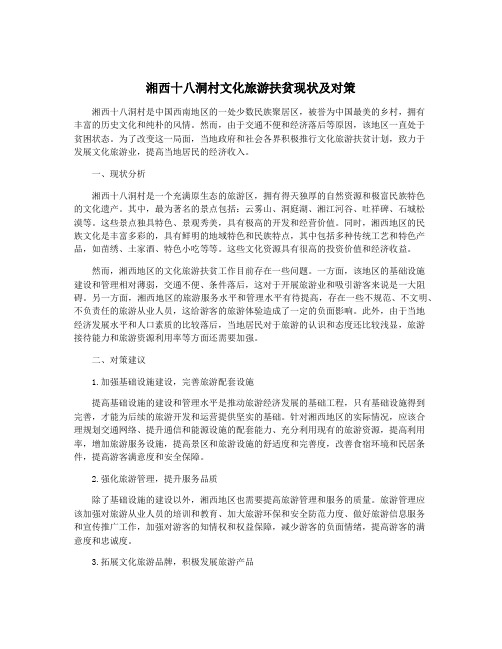
湘西十八洞村文化旅游扶贫现状及对策湘西十八洞村是中国西南地区的一处少数民族聚居区,被誉为中国最美的乡村,拥有丰富的历史文化和纯朴的风情。
然而,由于交通不便和经济落后等原因,该地区一直处于贫困状态。
为了改变这一局面,当地政府和社会各界积极推行文化旅游扶贫计划,致力于发展文化旅游业,提高当地居民的经济收入。
一、现状分析湘西十八洞村是一个充满原生态的旅游区,拥有得天独厚的自然资源和极富民族特色的文化遗产。
其中,最为著名的景点包括:云雾山、洞庭湖、湘江河谷、吐祥碑、石城松漠等。
这些景点独具特色、景观秀美,具有极高的开发和经营价值。
同时,湘西地区的民族文化是丰富多彩的,具有鲜明的地域特色和民族特点,其中包括多种传统工艺和特色产品,如苗绣、土家酒、特色小吃等等。
这些文化资源具有很高的投资价值和经济收益。
然而,湘西地区的文化旅游扶贫工作目前存在一些问题。
一方面,该地区的基础设施建设和管理相对薄弱,交通不便、条件落后,这对于开展旅游业和吸引游客来说是一大阻碍。
另一方面,湘西地区的旅游服务水平和管理水平有待提高,存在一些不规范、不文明、不负责任的旅游从业人员,这给游客的旅游体验造成了一定的负面影响。
此外,由于当地经济发展水平和人口素质的比较落后,当地居民对于旅游的认识和态度还比较浅显,旅游接待能力和旅游资源利用率等方面还需要加强。
二、对策建议1.加强基础设施建设,完善旅游配套设施提高基础设施的建设和管理水平是推动旅游经济发展的基础工程,只有基础设施得到完善,才能为后续的旅游开发和运营提供坚实的基础。
针对湘西地区的实际情况,应该合理规划交通网络、提升通信和能源设施的配套能力、充分利用现有的旅游资源,提高利用率,增加旅游服务设施,提高景区和旅游设施的舒适度和完善度,改善食宿环境和民居条件,提高游客满意度和安全保障。
2.强化旅游管理,提升服务品质除了基础设施的建设以外,湘西地区也需要提高旅游管理和服务的质量。
旅游管理应该加强对旅游从业人员的培训和教育、加大旅游环保和安全防范力度、做好旅游信息服务和宣传推广工作,加强对游客的知情权和权益保障,减少游客的负面情绪,提高游客的满意度和忠诚度。
湘西十八洞村文化旅游扶贫现状及对策

湘西十八洞村文化旅游扶贫现状及对策【摘要】湘西十八洞村是一个具有深厚文化底蕴的地方,而文化旅游对于扶贫具有重要意义。
目前该地区的文化旅游发展面临着一些问题和挑战,需要加强文化传承与挖掘,提升基础设施建设,并制定促进文化旅游扶贫政策。
通过这些措施的落实与成效评估,可以带动当地经济持续健康发展。
未来,湘西十八洞村的文化旅游扶贫有望取得更大的发展,为当地人民带来更多的机遇和福祉。
【关键词】湘西十八洞村、文化旅游、扶贫、现状、挑战、文化传承、基础设施、政策、发展、落实、成效评估、经济发展。
1. 引言1.1 湘西十八洞村背景介绍湘西十八洞村,位于湖南省张家界市永定区境内,是一个典型的山区小村庄。
该村地处深山峻岭之间,四面环山,交通不便,居民主要以农业为生。
十八洞村是湘西土家族自治州的重要组成部分,具有深厚的土家族文化底蕴。
据传统文化记载,湘西十八洞村曾是土家族首领的居所,历史悠久,文化积深。
村中保存着许多古老的文化遗迹和传统习俗,如土家族歌舞、饮食习俗、民间艺术等,展现了土家族独特的生活方式和价值观念。
由于长期以来的地理位置偏远和经济发展滞后,湘西十八洞村的文化遗产并未得到有效保护和传承,村民生活水平较低,存在着贫困现象。
为了改善当地居民的生活状况,发展文化旅游成为了一种重要的途径。
通过挖掘和利用土家族文化资源,吸引游客,提升村庄形象,促进经济发展,实现文化与扶贫的双赢局面成为了村庄面临的重要任务。
1.2 文化旅游对扶贫的重要性文化旅游还可以促进当地商品和农产品的销售。
游客在文化旅游过程中,除了参观当地的景点和文化遗产,还会购买一些当地特色的商品和农产品,这样一来,可以带动当地农民和手工艺人的生产,促进当地经济的繁荣。
文化旅游对于扶贫工作的重要性不可忽视,通过发展文化旅游业,可以有效地改善贫困地区的经济发展状况,提升当地居民的生活水平。
2. 正文2.1 湘西十八洞村的文化旅游发展现状湘西十八洞村地处湖南省湘西土家族苗族自治州,是一个依山而建的传统村落。
湘西十八洞村文化旅游扶贫现状及对策
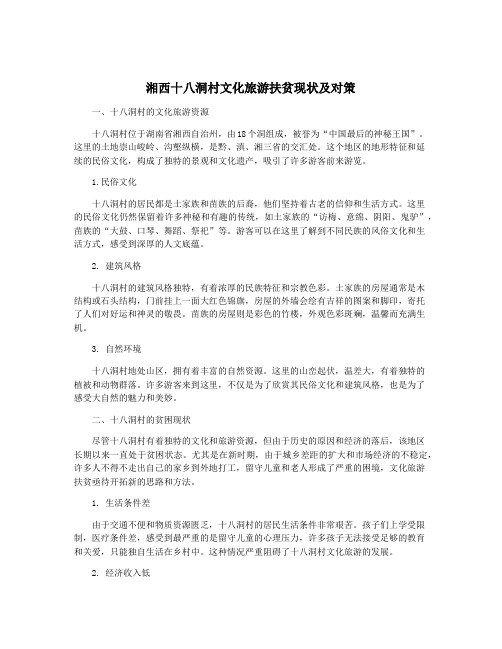
湘西十八洞村文化旅游扶贫现状及对策一、十八洞村的文化旅游资源十八洞村位于湖南省湘西自治州,由18个洞组成,被誉为“中国最后的神秘王国”。
这里的土地崇山峻岭、沟壑纵横,是黔、滇、湘三省的交汇处。
这个地区的地形特征和延续的民俗文化,构成了独特的景观和文化遗产,吸引了许多游客前来游览。
1.民俗文化十八洞村的居民都是土家族和苗族的后裔,他们坚持着古老的信仰和生活方式。
这里的民俗文化仍然保留着许多神秘和有趣的传统,如土家族的“访梅、意绵、阴阳、鬼驴”,苗族的“大鼓、口琴、舞蹈、祭祀”等。
游客可以在这里了解到不同民族的风俗文化和生活方式,感受到深厚的人文底蕴。
2. 建筑风格十八洞村的建筑风格独特,有着浓厚的民族特征和宗教色彩。
土家族的房屋通常是木结构或石头结构,门前挂上一面大红色锦旗,房屋的外墙会绘有吉祥的图案和脚印,寄托了人们对好运和神灵的敬畏。
苗族的房屋则是彩色的竹楼,外观色彩斑斓,温馨而充满生机。
3. 自然环境十八洞村地处山区,拥有着丰富的自然资源。
这里的山峦起伏,温差大,有着独特的植被和动物群落。
许多游客来到这里,不仅是为了欣赏其民俗文化和建筑风格,也是为了感受大自然的魅力和美妙。
二、十八洞村的贫困现状尽管十八洞村有着独特的文化和旅游资源,但由于历史的原因和经济的落后,该地区长期以来一直处于贫困状态。
尤其是在新时期,由于城乡差距的扩大和市场经济的不稳定,许多人不得不走出自己的家乡到外地打工,留守儿童和老人形成了严重的困境,文化旅游扶贫亟待开拓新的思路和方法。
1. 生活条件差由于交通不便和物质资源匮乏,十八洞村的居民生活条件非常艰苦。
孩子们上学受限制,医疗条件差,感受到最严重的是留守儿童的心理压力,许多孩子无法接受足够的教育和关爱,只能独自生活在乡村中。
这种情况严重阻碍了十八洞村文化旅游的发展。
2. 经济收入低由于十八洞村是一个传统农业村庄,经济基础薄弱,居民的收入水平很低。
很多时候,他们还要为了维持生计而垫付住房、卫生、食品和教育的开销。
幸福苗寨踏歌来——精准扶贫首倡地湖南十八洞村见闻
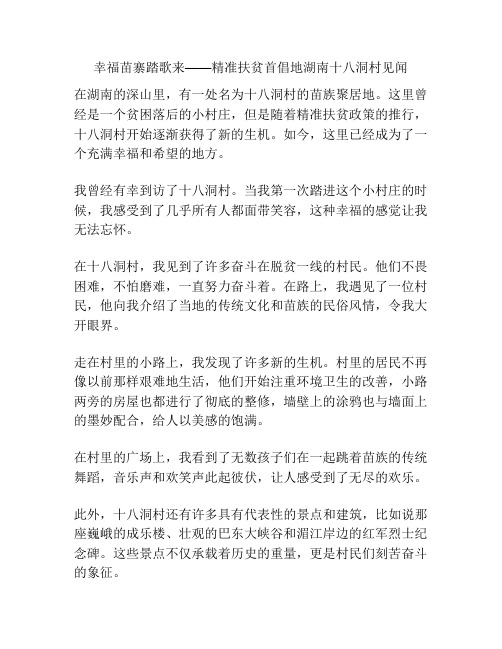
幸福苗寨踏歌来——精准扶贫首倡地湖南十八洞村见闻
在湖南的深山里,有一处名为十八洞村的苗族聚居地。
这里曾经是一个贫困落后的小村庄,但是随着精准扶贫政策的推行,十八洞村开始逐渐获得了新的生机。
如今,这里已经成为了一个充满幸福和希望的地方。
我曾经有幸到访了十八洞村。
当我第一次踏进这个小村庄的时候,我感受到了几乎所有人都面带笑容,这种幸福的感觉让我无法忘怀。
在十八洞村,我见到了许多奋斗在脱贫一线的村民。
他们不畏困难,不怕磨难,一直努力奋斗着。
在路上,我遇见了一位村民,他向我介绍了当地的传统文化和苗族的民俗风情,令我大开眼界。
走在村里的小路上,我发现了许多新的生机。
村里的居民不再像以前那样艰难地生活,他们开始注重环境卫生的改善,小路两旁的房屋也都进行了彻底的整修,墙壁上的涂鸦也与墙面上的墨妙配合,给人以美感的饱满。
在村里的广场上,我看到了无数孩子们在一起跳着苗族的传统舞蹈,音乐声和欢笑声此起彼伏,让人感受到了无尽的欢乐。
此外,十八洞村还有许多具有代表性的景点和建筑,比如说那座巍峨的成乐楼、壮观的巴东大峡谷和湄江岸边的红军烈士纪念碑。
这些景点不仅承载着历史的重量,更是村民们刻苦奋斗的象征。
在十八洞村,我最大的收获就是那种来自居民的幸福感。
他们现在更加自豪地说起自己的家乡,因为他们有了更好的环境和希望。
通过这次参观,我感受到了十八洞村因精准扶贫得以重获新生,更感到了这个地方充满的爱和希望。
今天的十八洞村已经成为了一个具有现代意义的小城镇,也可以说是一个充满幸福和人文的苗寨。
湘西十八洞村文化旅游扶贫现状及对策

湘西十八洞村文化旅游扶贫现状及对策湘西十八洞村位于湖南省境内,是中国重点扶贫村之一。
由于交通闭塞、资源匮乏等因素,这些村庄长期以来一直存在贫困问题。
湘西十八洞村拥有悠久的历史和独特的民族文化,为发展文化旅游产业提供了巨大的潜力。
本文将重点探讨湘西十八洞村文化旅游扶贫的现状及对策。
湘西十八洞村的文化旅游资源丰富多样,包括梦幻湘西、乡村旅游、红色旅游等多个方面。
梦幻湘西以乡村风貌、特色建筑和民俗文化为主要内容,吸引了大量游客前来游览。
乡村旅游则将游客带入湘西的农村景观,让他们亲身体验农村生活。
红色旅游则以红色文化为主题,展示了湘西在中国革命历史上的重要地位。
湘西十八洞村的文化旅游发展仍存在一些问题。
交通不便是一个主要的障碍。
这些村庄多位于山区,交通闭塞,道路狭窄,不方便游客前往。
基础设施薄弱。
村庄的酒店、餐饮等旅游设施相对落后,无法满足游客的需求。
旅游服务水平有待提高。
由于缺乏专业人才和相关培训,当地居民在接待游客、讲解文化等方面还存在一定的问题。
1. 优化交通网络为了解决交通不便的问题,应加快改善湘西十八洞村的交通网络。
修建更宽阔的道路,提高通行能力,增加公交线路,方便游客的出行。
要加大对交通设施的投入,修建更多的停车场和休息区,为游客提供更好的服务。
2. 提升基础设施建设为了满足游客的需求,湘西十八洞村需要加大对旅游设施的建设。
引进一些知名的酒店集团,提高酒店的档次和服务水平。
鼓励当地居民发展农家乐、民宿等形式的旅游住宿,增加农民的收入。
3. 加强人才培养为了提高旅游服务质量,湘西十八洞村需要加强人才培养。
建立专业的旅游培训机构,为当地居民提供相关培训和资格认证。
引进一些专业的导游、讲解员等人才,提供更专业的服务。
4. 加大宣传力度为了吸引更多的游客,湘西十八洞村需要加大宣传力度。
利用互联网、新媒体等渠道,宣传湘西的独特文化和美丽风景,吸引游客的关注。
要与其他旅游景点进行合作,打造更具吸引力的旅游线路,提升湘西的知名度。
精准扶贫视野下湘西十八洞村乡村旅游发展研究

精准扶贫视野下湘西十八洞村乡村旅游发展研究作者:邹欢李盼来源:《当代体育科技》2018年第26期摘要:基于精准扶贫视野,采用文献资料法、实地考察法、专家访谈法等研究方法对湘西十八洞村精准扶贫开发与乡村旅游发展现状进行研究,通过探究发现其乡村旅游发展过程中存在公共基础服务设施落后、产品同质化,缺乏核心竞争力、经营项目单一,文化内涵深度挖掘不够、专业技术人才短缺,服务水平不高等问题,并针对所存在的问题提出了完善基础设施建设、进一步开发乡村旅游资源、深挖文化内涵,开发特色化产品、加强从业人员培训,提高管理和服务水平等意见与对策,以期为湘西十八洞村乡村旅游的发展提供一定的借鉴和参考。
关键词:精准扶贫十八洞村乡村旅游中图分类号:G812 文献标识码:A 文章编号:2095-2813(2018)09(b)-0247-021 湘西十八洞村精准扶贫开发与乡村旅游发展现状十八洞村坐落于湖南省湘西土家族苗族自治州花垣县双龙镇,因村内有18个天然溶洞组成的巨大溶洞群而得名,是一个山高林密、交通闭塞、人均耕地仅为0.83亩的贫困苗族村寨。
2013年11月,国家主席、中共中央总书记习近平于十八洞村考察时首提“精准扶贫”理念。
那年,十八洞村居民人均纯收入仅为1688元,是当年中国农民人均纯收入的18.75%。
然而,时隔5年,在党中央“精准扶贫”政策指引下,十八洞村发生了翻天覆地的变化。
家家户户全面实现通水、通电、通路、通网,并初步形成了以乡村旅游业为龙头,种植业、养殖业、手工艺加工业、劳务输出业等其他产业联动发展的发展思路。
至2016年,十八洞村人均纯收入从2013年的1668元增长至8313元,增长了近四倍。
2017年2月,湖南省扶贫办宣布十八洞村成功脱贫摘帽,成为了全国精准扶贫的一面旗帜。
乡村旅游是助力湘西十八洞村实现“精准脱贫”的重要的途径之一。
近年来,十八洞村立足苗寨特色和习近平总书记来此考察而提高的知名度,以农家乐新项目为突破口,通过全体村民集思广益共同开发推出十八洞腊肉、农家豆腐、苗鱼、苗鸭、野菜、苞谷烧等民族特色菜肴,并将乡村旅游与手工工艺、民俗活动等有效结合,一定程度上形成了十八洞村有别于其他乡村旅游地的有效竞争力。
- 1、下载文档前请自行甄别文档内容的完整性,平台不提供额外的编辑、内容补充、找答案等附加服务。
- 2、"仅部分预览"的文档,不可在线预览部分如存在完整性等问题,可反馈申请退款(可完整预览的文档不适用该条件!)。
- 3、如文档侵犯您的权益,请联系客服反馈,我们会尽快为您处理(人工客服工作时间:9:00-18:30)。
Sustainable Development 可持续发展, 2019, 9(3), 321-332Published Online July 2019 in Hans. /journal/sdhttps:///10.12677/sd.2019.93040Protection and Tourism Development ofTraditional Villages from the Perspective of Targeted Poverty Alleviation—Take Shibadong Village of Huayuan County in Hunan Province as an ExampleTianzhao Liu, Peilin Liu, Yunqiu Shi, Huijun Peng, Chiqin Huang, Xiaoyan LiuCollege of City and Tourism, Hengyang Normal University, Hengyang HunanReceived: June 11th, 2019; accepted: June 26th, 2019; published: July 3rd, 2019AbstractAs a traditional Chinese village, Shibadong village needs to protect its architectural style and cul-ture. As a poverty-stricken and backward area, in order to get rid of poverty and become rich and realize rural revitalization, Shibadong Village needs to develop and utilize its most advantageous village landscape and national cultural resources, which will undoubtedly bring some negative ef-fects on traditional villages. Through on-the-spot investigation and questionnaire survey of Shi-badong Village, the author comprehensively understands the opinions of local residents on pre-cise poverty alleviation, protection and tourism development of traditional villages, analyzes the problems existing in protection and tourism development of traditional villages, and puts forward corresponding countermeasures. The author believes that tourism development should be carried out on the premise of village protection, and the income of local residents should be increased through tourism development. This will promote the protection of villages, achieve the balanced development of targeted poverty alleviation, village protection and tourism development and ul-timately achieve the sustainable development of traditional villages.KeywordsTargeted Poverty Alleviation, Traditional Villages, Protection and Development, Shibadong Village精准扶贫视域下传统村落的保护与旅游开发——以湖南省花垣县十八洞村为例刘天曌,刘沛林,石韵秋,彭惠军,黄翅勤,刘晓燕衡阳师范学院城市与旅游学院,湖南衡阳刘天曌 等收稿日期:2019年6月11日;录用日期:2019年6月26日;发布日期:2019年7月3日摘要作为中国传统村落,十八洞村需要保护好建筑风貌和村落文化。
而作为贫困落后地区,要想脱贫致富,实现乡村振兴,十八洞村需要将其最具优势的村落景观和民族文化资源加以开发利用,这无疑又会对传统村落带来一些消极影响。
通过对十八洞村的实地考察和问卷调查,全面了解当地居民对于精准扶贫、传统村落的保护与旅游开发的意见,分析传统村落保护与旅游开发存在的问题,并提出相对应的对策措施,认为应在村落保护的前提下进行旅游开发,通过旅游开发提高当地居民的收入,以此来促进村落的保护,使精准扶贫、村落的保护与旅游开发三者平衡发展,最终实现传统村落的可持续发展。
关键词精准扶贫,传统村落,保护与开发,十八洞村Copyright © 2019 by authors and Hans Publishers Inc.This work is licensed under the Creative Commons Attribution International License (CC BY). /licenses/by/4.0/1. 引言2013年习总书记到湘西考察后,首次提出“精准扶贫”的战略思想。
所谓精准扶贫,是指针对不同贫困区域环境、不同贫困农户状况,运用科学有效程序对扶贫对象实施精确识别、精确帮扶、精确管理的治贫方式。
精准扶贫是新时期党和国家扶贫开发工作的重点,是全面建成小康社会、实现中华民族伟大“中国梦”的关键。
我国贫困地区大多是交通不便的偏远山区,这里生态环境优美,传统建筑保存完好,地域民族风情浓郁,广泛分布着大量传统村落。
近年来,通过实施精准扶贫,开发传统村落旅游,许多贫困地区的居民摘掉了贫困的帽子,日子越过越红火。
但是随着传统村落的开发利用,一些传统村落遭到不同程度的破坏,当地特色的建筑逐渐被现代建筑取代,当地传统文化习俗也在逐渐消亡。
传统村落保护与开发日渐受到学者关注,如王云才[1]等(2006)以门头沟区为例探讨了北京西部山区传统村落的保护与旅游开发利用,韦亚(2013) [2]以黔西南州望谟布依族村落为例,对布依族传统村落保护与文化生态式的乡村旅游开发进行了研究,张剑文(2016) [3]对传统村落保护与旅游开发的PPP 模式研究,刘天曌等(2016) [4]以张谷英村为例,对传统村落旅游农户感知、态度与行为进行了研究,宋河有(2017) [5]对传统村落旅游化保护的风险及其防范进行了研究,黄杰等(2018) [6]对少数民族传统村落活化与旅游开发的互动性进行了研究,赵孟莹(2018) [7]探讨了旅游开发与传统村落原真性保护的路径,另外还有江志国等(2016) [8]从利益主体视角对福建省、刘万柳(2017) [9]对湖南省的传统村落保护与利用进行了研究;其次是从不同的战略背景研究传统村落的保护与发展,如周乾松(2013) [10]和刘天曌等(2019) [11]从新型城镇化的进程中、李金峰等(2018) [12]从乡村旅游视野下、刘瑞雪(2006) [13]从乡村振兴的背景下分别对传统村落的保护与发展进行了研究。
而作为习近平总书记“精准扶贫”战略思想的首倡地,十八洞村近年来也成为学者研究的热点,主要聚焦在精准扶贫上,如刘宗林(2016) [14]概括总结了十八洞村合作社精准扶贫的做法,邹欢等(2018) [15]、张红艳(2018) [16]对十八洞村的乡村旅游发展进行了研究,文理中(2018)刘天曌等[17]对十八洞村体育旅游开发模式的研究。
作为中国传统村落,十八洞村需要保护好建筑风貌和村落文化。
而作为贫困落后地区,要想脱贫致富,实现乡村振兴,十八洞村需要将其最具优势的村落景观和民族文化资源加以开发利用,这无疑又会对传统村落带来一些消极影响。
如何平衡十八洞村开发与保护的关系,实现其可持续发展,是具有现实意义的问题。
纵观前述研究,还没有学者从精准扶贫的视角研究十八洞村的保护与旅游开发问题。
本文通过实地调研、设计调查问卷以及了解当地状况,全面了解当地居民对于精准扶贫、传统村落的保护与旅游开发的意见,分析传统村落保护与旅游开发存在的问题,并提出相对应的对策措施,能为传统村落的保护与开发以及村落精准扶贫工作提供一些可行性的建议。
2. 研究区域概况及研究设计2.1. 十八洞村概况十八洞村是一个传统的苗家村寨,因村域内的莲台山有由十八个叉洞相连而成的大溶洞而得名,相传为古夜郎国战败后的藏身之所,因此亦称“夜郎十八洞”。
十八洞村位于湖南省西部,武陵山脉中段,湘黔渝交界处的湘西土家族苗族自治州花垣县双龙镇西南部,紧临包茂高速G65和国道G209,距G65矮寨互通高速出口和矮寨奇观景区约15 km,距花垣县城约33 km,距州府吉首市约37 km,交通区位条件良好,如图1。
全村由梨子寨、竹子寨、飞虫寨、当戎寨4个自然寨组成,人口约939人,是一个纯苗聚居区,因为过去地处偏远山区而且交通闭塞,传统建筑风貌和原生态民族文化保存完好,打苗鼓、接龙、抢狮、过苗年、赶秋节、山歌传情等民俗风情丰富多彩。
十八洞村属于高山岩溶地区,为亚热带季风气候,村寨周围群山环绕,植被茂密,地质地貌景观奇特,生态环境优美,村境周边还有莲台山林场、黄马岩、乌龙一线天、背儿山、擎天柱等风景旅游资源点。
十八洞村2016年先后被住建部评选为第三批美丽宜居村庄和第四批中国传统村落,2017年入选第二批中国少数民族特色村寨名单,2018年初被批准为国家3A级旅游景区,后又被农业农村部推介为“中国美丽休闲乡村”,被中国生态文化协会授予全国生态文化村称号,2018年被列入中央财政支持范围的中国传统村落名单。
注:景观图片来源于网络Figure 1.Shibadong Village Location and Village Landscape图1.十八洞村区位及村落景观图刘天曌等2.2. 研究设计为了全面了解十八洞村的保护与开发状况,掌握当地居民对精准扶贫、传统村落保护、旅游开发等问题的看法,课题组成员于2018年3月16~18日前往十八洞村进了为期3天的考察和调研,除了实地走访,还向当地村民发放了200份问卷,收回176份,最终获得有效问卷150份,被调查者的人口统计分析如表1。
